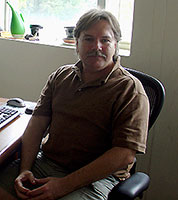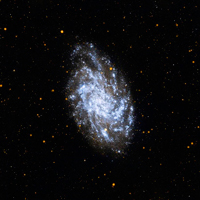Tim Conrow
An Engineer Who Builds Pipelines to Galaxies
Profile by Sandi Beck

He grew up reading Asimov's science-for-the-layman books and wanted to work in science or math, but couldn't, as a youngster, really pin it down to one field. "I remember spending most of my time daydreaming about astronomy and spaceflight," muses Tim Conrow, GALEX'S Pipeline Architect and Lead Data Analysis Developer. "So, even though I can't say I ever consciously decided I wanted to be in the space program, in retrospect it seems like that's where I was headed."
His title, "pipeline architect," conjures up images of building the large pipe that carries Alaskan oil across that state's frozen tundra. Not the case. Instead, Conrow designed the overall "data pipeline" that automatically takes science telemetry from GALEX, a galaxy-observing space telescope, and turns it into data that the mission's science team can analyze.
Conrow, together with the GALEX system administrator, designed the hardware system and acquired the computer hardware for the pipeline to run on. Then once GALEX was in place, studying galaxies in ultraviolet (UV) light across 10 billion years of cosmic history, Conrow began overseeing delivery and processing of the data from the two remotely located ground stations (South Point, Hawaii, and Dongara, Australia). He's also responsible for fixing software "bugs" and other problems, as well as monitoring resource utilization, supporting data quality assurance, and coordinating data releases to the science team (and later to the public). Additionally, Conrow is involved with the Guest Investigator program, where guest observers can propose specific science investigations and reserve time for their observations. These varied tasks keep his work days interesting.
Says Conrow, "I like small missions like GALEX -- you get to stick your fingers into more pies."
Conrow's journey to the GALEX mission began when, after a brief flirtation with the Math Department, he became a physics major at California State University at Los Angeles. One afternoon of mid 1982, late in the academic year, one of his professors asked if the Cal State LA senior would be interested in working at the Jet Propulsion Laboratory (JPL). The professor's neighbor was looking for students to work on the Infrared Astronomical Satellite (IRAS) project during the summer. Conrow interviewed and got the job, which he started upon graduation. With a Bachelors of Science, Conrow found himself in a place where science fiction could become fact.
"Woohoo! I was in the space program!" he exults. "Everyone's job hunt should be so easy."
Following that summer employment, Conrow transitioned to academic part time at JPL while pursuing graduate-level physics courses for the next two years. His job then became a full time one, developing IRAS data products, and when the IRAS project moved onto the Caltech campus at the Infrared Processing and Analysis Center, he went with it. From IRAS, he worked briefly on 2MASS and then took the job as the data processing pipeline architect and lead data analysis developer for the WIRE project. When, sadly, the WIRE instrument failed shortly after launch in 1999, Conrow transitioned to the GALEX project, where he has performed the same type of work.
Conrow hopes that GALEX will have the kind of long-term impact in its ultraviolet observations that IRAS had in its infrared observations. "I'd like to see GALEX change the way astronomers look at problems," he explains. "The mission's database will provide a greater degree of statistical rigor to many problems than was possible before. Plus, they'll have by far the most comprehensive dataset ever in the UV for looking for new phenomena."
The engineer is still thinking about where he wants his career to go between now and retirement in, hopefully, 20 years or so. After GALEX, he's looking forward to participating in the WISE project, which he hopes will provide new experiences. For now, he's quite proud of the low-cost ground systems he's helped to develop for both WIRE and GALEX.
"Those are group achievements, with a lot of luck mixed in too," he points out. "Even so, I think I made some contributions to be proud of."




